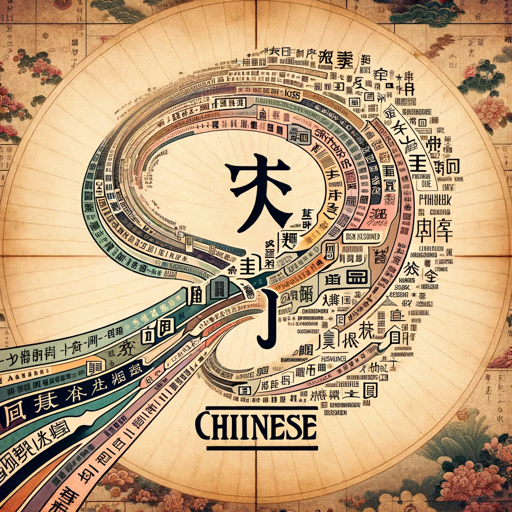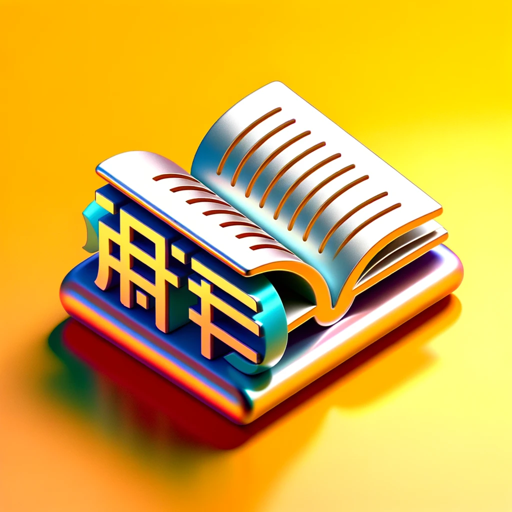翻訳えもん(中国語版)-AI Chinese-Japanese translation
AI-powered Chinese-Japanese translation tool
1.【音声翻訳】 中国語⇨日本語
2.【音声翻訳】 日本語⇨中国語
3.【テキスト翻訳】 中国語⇨日本語
4.【テキスト翻訳】 日本語⇨中国語
Related Tools
Load More
日中翻译
输入中文自动翻译为日语,输入日语自动翻译为中文
翻訳君
原文をコピペするだけで翻訳してくれます。デフォルトでは日→英、または全ての外国語→日。

Translate to Chinese
Auto-translates any language to Chinese. 自动翻译任何语言到中文。

中文先生(繁體中文讀者)🐉
讓學習中文單字變得更有趣又輕鬆。

English 翻译天团
精准翻译家:让英语老师、中文老师和校长共同帮你翻译英文文章。Credit @dotey

翻訳えもん(英語版)
🇺🇸日常会話口調に素早く翻訳🇺🇸翻訳結果以外の余計なテキストが一切記載されないため、ストレスなくスムーズに翻訳できます!使い方は「翻訳開始」とプロンプト送信するか、下記トリガーフレーズを送信すると翻訳が開始します。 ⭐️日本語・英語を直入力しても翻訳されます⭐️
20.0 / 5 (200 votes)
Introduction to 翻訳えもん(中国語版)
翻訳えもん(中国語版) is a customized version of ChatGPT designed to facilitate seamless translation between Chinese and Japanese. Its primary functions are to translate spoken and written content accurately and naturally. The service ensures that the translations are contextually appropriate, making it a valuable tool for various communication needs. For example, a business professional can use 翻訳えもん(中国語版) to translate emails from Chinese to Japanese to ensure clear communication with Japanese clients. Additionally, a student studying Japanese can use the tool to translate Chinese texts into Japanese for academic purposes.

Main Functions of 翻訳えもん(中国語版)
Voice Translation (Chinese to Japanese)
Example
A Chinese tourist in Japan needs to ask for directions and uses 翻訳えもん(中国語版) to translate their question from Chinese to Japanese.
Scenario
The tourist speaks their question into the tool, which then provides a clear and natural translation in Japanese, enabling effective communication with locals.
Voice Translation (Japanese to Chinese)
Example
A Japanese tour guide assisting Chinese-speaking tourists uses 翻訳えもん(中国語版) to translate information about local attractions from Japanese to Chinese.
Scenario
The guide speaks in Japanese, and the tool translates the information into Chinese, allowing the tourists to understand and enjoy their tour fully.
Text Translation (Chinese to Japanese)
Example
A Chinese company translating its product manuals into Japanese for the Japanese market.
Scenario
The company inputs the Chinese text into 翻訳えもん(中国語版), which then provides a precise and natural Japanese translation suitable for the manuals.
Text Translation (Japanese to Chinese)
Example
A Japanese publisher translating a Japanese novel into Chinese for a Chinese audience.
Scenario
The publisher inputs the Japanese text into the tool, which then delivers a fluent and culturally relevant Chinese translation.
Ideal Users of 翻訳えもん(中国語版)
Business Professionals
Business professionals engaged in cross-border trade between China and Japan can use 翻訳えもん(中国語版) to translate emails, contracts, and other business documents, ensuring accurate and effective communication.
Tourists and Tour Guides
Tourists visiting Japan and Japanese tour guides assisting Chinese-speaking tourists can benefit from real-time voice translation services provided by 翻訳えもん(中国語版) to overcome language barriers and enhance their travel experience.
Students and Academics
Students and researchers working with Chinese and Japanese texts can use 翻訳えもん(中国語版) to translate academic papers, textbooks, and study materials, aiding in their understanding and research.
Publishing Industry
Publishers looking to expand their market reach by translating literary works between Chinese and Japanese can rely on 翻訳えもん(中国語版) for high-quality translations that retain the original text's nuance and style.

How to Use 翻訳えもん(中国語版)
Step 1
Visit aichatonline.org for a free trial without login, also no need for ChatGPT Plus.
Step 2
Select the translation type you need from the main menu: Voice Translation (Chinese ⇨ Japanese or Japanese ⇨ Chinese) or Text Translation (Chinese ⇨ Japanese or Japanese ⇨ Chinese).
Step 3
Input your text or upload your voice recording for translation. Ensure that your input is clear for the best results.
Step 4
Receive your translated text instantly. For voice translations, listen to the audio output or read the transcribed text.
Step 5
For optimal experience, use the tool in a quiet environment for voice inputs and ensure proper internet connectivity for uninterrupted service.
Try other advanced and practical GPTs
Make My Home
AI-Powered Custom Home Design Tool

論文査読ボット
AI-powered peer reviews for academic papers.

BlogGenius - Blog and Posts Series Writer SEO
AI-powered Blog and SEO Content Creation

Gif Animator
Create stunning GIFs with AI.

Poe Bot Creator
Create AI-Powered Chatbots Effortlessly

Global City Landmark, Weather, and News Assistant
AI-powered city insights at your fingertips.

Future Forward Business Builder
AI-powered solutions for future-forward business growth

Dorico 5 Assistant (unofficial!)
AI-Powered Assistance for Dorico Users

Word Search Content Generator
AI-powered tool for custom word searches.

Chef GPT
AI-powered recipes, ingredients, and more.

나랑 닮은 디즈니스타일 캐릭터는? (D-style character)
Create Your Disney-style Character with AI.

Prof. Pixel
AI-powered tool for smart learning

- Academic Writing
- Business Communication
- Travel Assistance
- Personal Correspondence
- Real-time Conversations
Q&A about 翻訳えもん(中国語版)
What is 翻訳えもん(中国語版)?
翻訳えもん(中国語版) is an AI-powered translation tool designed to provide instant and accurate translations between Chinese and Japanese. It supports both text and voice translations.
How do I start using 翻訳えもん(中国語版)?
You can start using the tool by visiting aichatonline.org, where you can try it for free without needing to log in or subscribe to ChatGPT Plus.
What types of translations does 翻訳えもん(中国語版) support?
It supports both voice and text translations. You can translate from Chinese to Japanese and vice versa, making it versatile for various use cases.
Are there any prerequisites for using 翻訳えもん(中国語版)?
No prerequisites are required. Just visit the website, select your translation type, and input your text or voice. Ensure a stable internet connection for the best experience.
What are some common use cases for 翻訳えもん(中国語版)?
Common use cases include academic writing, business communication, travel assistance, personal correspondence, and real-time conversations between Chinese and Japanese speakers.